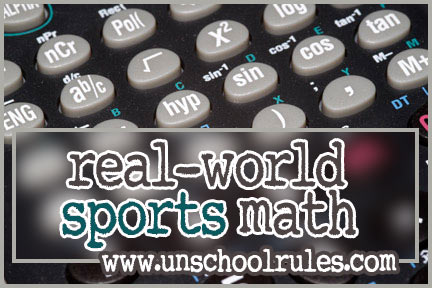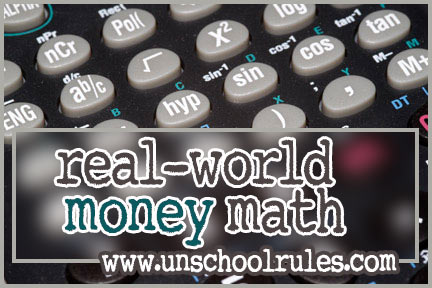I’ve got a bachelor’s degree in advanced math, and a 12-year-old daughter who hates anything to do with the subject.
I’m an unschooling mama who loves to do math puzzles and logic problems for fun.
I’m not sure if that combination makes me an expert or just crazy, but because of it, I agreed to take part in the iHomeschool Network’s “5 days of…” series this week with a look at 5 days of real-world math.
Today, we’ll look at three types of math you need to play sports and do other fun stuff.
Work your angles: Geometry in bowling, billiards, building and more
Almost any sport with a ball works based on angles.
In baseball, it’s easier to hit a home run to either right or left field than it is to the center, because, with the shape of the field, the distance you need to hit the ball is shorter. In bowling, if you tip a pin more than 13 degrees to either side, it will fall; that’s called the “topple angle.” In billiards, of course the entire game is dependent on the angle at which you hit the cue, and the angle at which the ball you’re aiming for hits the edges of the table.
Meanwhile, almost anything fun to build requires solid shapes and angles.
Whether you’re working with Legos, blocks, K’nex, stacking cups, houses of cards or whatever, you’ll soon realize what foundations make for strong structures and which end up falling over.
You will probably never in your real life get out a protractor and measure angles. However, if you’re conscious of it, you’ll be able to spot a lot of math, especially geometry, in your favorite sports, and you can pretty intuitively develop the knowledge that right angles are sturdy, that hitting EXACTLY on the head pin in bowling is actually worse than hitting it just slightly to one side, that you can change the angle at which the baseball flies by hitting it with the early or late part of your swing.
Where to start: If you have a Wii video-game system, play Wii Sports. A lot. I’m not kidding; this is the way we’ve worked on angles in everything from golf to bowling to baseball.
You will be amazed at what you – and your children of all ages – will pick up from that.
Barring the Wii, watch sports. Watch them in person, watch them on TV, watch them online. If you can, PLAY sports. You don’t need to play them in an organized fashion for this. Go to a tennis court and hit the balls around, and talk about what you notice about the angle at which the ball flies depending on the angle of your racket.
Play an “angle bounce” game. Have one person stand against the garage door or another large wall, and have someone else stand several feet away; mark that person’s starting spot with an X, and from there, have that person throw a ball at the door. (NOT into the person standing there, though!)
The person standing near the door should try to put their hand near where they saw the ball hit the door, and the person who threw the ball should go try to put their foot where the ball bounces back. It’s a goofy game – you’ll both be running around like crazy – but if your thrower starts at the X each time, you’ll get a feel for all the different ways things bounce and angles and all.
For kids who actually play sports like baseball or soccer, videotape their practices and see if you can point out any “angles” they can work to change their game. Watch videos of professionals, too, and notice their angles!
Finally, build stuff. Build with blocks or Legos or plastic cups or playing cards, and experiment to see if you can find shapes that allow you to build taller or stronger.
There’s no right or wrong answer here, but for any age, this is a fun way to see geometry in action.
Go, speed racer: Physics in your favorite sports
Right up there with geometry in terms of “stuff you really use” is physics. Stuff moves. It moves the way it does for a reason. That’s physics at its simplest.
Much like with angles, most sports played with a ball incorporate a heavy dose of physics. Why is it harder to sink a close shot in basketball than a medium-distance one? When is the pitch FASTEST in baseball – when it leaves the pitcher’s hand, or when it connects with the bat? (That’s a trick question – it’s actually technically a complete stop, zero on the acceleration scale, for the split second when it hits the bat, before it starts moving in the other direction.)
Where to start: You can certainly get a great dose of physics by watching NASCAR – or any other kind of race. Watch the runners – or any other athletes – in the summer Olympics. Talk about what they’re doing, and guess why (then do some research to check your guesses.)
If you’re interested in baseball, one of my favorite sites, Exploratorium (remember them from the recipe conversions?) offers a great “science of baseball” page here. They’ve also got a great collection of “sports science” resources overall here.
Real-world physics is perhaps the easiest type of math to experiment with. Drop stuff. Race Matchbox cars. Race marbles down ramps of different sizes. You can make some incredibly complex experiments with multiple variables for older kids, or you can do real neat “drop different-sized balls and see which one hits first” experiments with younger kids.
Mostly, keep an eye on all the movement around you. This becomes important later in life when you drive a car. I truly believe that kids who have an awareness of motion and how it does – and doesn’t – work are intuitively better drivers than those who are less motion-aware.
Smarter than the “average” bear: Statistics are fun (honest)
What, statistics? That’s, like, numbers for really boring people, right?
You wound me. I really like statistics – but I also know how easily they’re manipulated.
Our whole family loves following the stats for our favorite team, the Phillies. (Less so this year than in previous ones, but I digress.) Talk about a wealth of math that you don’t even realize – win/loss ratios, earned-run averages, batting averages; you name it, baseball can calculate it.
But, while sports are cool, the most important reason to understand statistics as an adult is to be sure you’re not being lied to. Check out any presidential campaign – or any “research study” put out by a company with an interest in your purchases.
Every day, you read “numbers” in life that are designed to motivate you to act – either to encourage you TO do something, or to encourage you NOT to. If you’re not good with numbers, that’s fine. Realize, though, that if you can gain an awareness to “think twice” about any statistics you see, you’ll be better off than most people around the world!
Where to start: Even young children can keep track of wins and losses for a favorite team. If you don’t have rabid fandom in your house, pick the most local team you can – because, as a bonus, you can watch some of their games in person. Check your local newspaper to see what information they publish after each of that team’s games. Follow along; compare your team to other teams in the same league.
Not into sports? Look for the “stats” in your favorite hobby! One of Ashar’s favorite hobbies is birdwatching. She loves to keep track of which food attracts which birds, and how many of each type of bird she sees in a particular season.
We don’t do that officially, but you could easily write it down and draw some statistical conclusions.
Finally, check the news – and more importantly, check commercials – for “statistics” stories. See if you and your kids can brainstorm some tough questions about the research.
And check your packaging – we’re often told that something is “25% better” or “40% bigger” or “80% healthier,” but in comparison with what? 40% bigger than the smaller size of the same brand? Uh, OK, sure. That’s a statistic that’s designed to encourage you to purchase the larger size, right? Don’t fall for it – go back to your “grocery math” and check unit price!
The rest of the series
Sunday: When numbers matter: A look at math in the real world (introduction)
Monday: The math you need at the grocery store
Tuesday: The math you need in your kitchen
Wednesday: The math you need to manage your money
Today: The math you need to play sports and do other fun stuff (yes, really!)
Friday: Real-world math resources you’ll love
More five-day fun
This post is part of the iHomeschool Network’s summer “Five Days Of…” series. Click the collage below to see how some of my fellow bloggers are spending their “five days,” and to learn more about our series sponsor, the BEECH Retreat bloggers’ conference!




